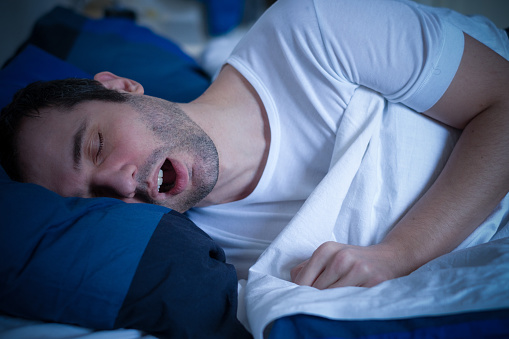 Sleep apnea is characterized by many interruptions in breathing throughout the night. It can happen if your body isn't getting enough oxygen. If you snore loudly, repeatedly gasp while sleeping, or encounter other symptoms of poor sleep quality, such as increased daytime sleepiness, you should consult and at Sleep Apnea Solutions of Cincinnati.
Sleep apnea is characterized by many interruptions in breathing throughout the night. It can happen if your body isn't getting enough oxygen. If you snore loudly, repeatedly gasp while sleeping, or encounter other symptoms of poor sleep quality, such as increased daytime sleepiness, you should consult and at Sleep Apnea Solutions of Cincinnati. Types of Sleep Apnea
There are various different types of sleep apnea that you should be aware of:
Obstructive Sleep Apnea
When your upper airway becomes obstructed repeatedly throughout the night, preventing airflow or limiting its volume, you have obstructive sleep apnea. This form of sleep apnea affects many people. Enlarged tonsils, obesity, and fluctuations in hormone levels are all risk factors for obstructive sleep apnea because they restrict the airway.
Central Sleep Apnea
This type of sleep apnea occurs when the brain fails to deliver signals to the body's breathing centers during sleep. Central sleep apnea is caused by problems with your airway and chest muscles that your brain is supposed to be controlling.
Symptoms of Sleep Apnea
It can be challenging to tell if you have obstructive or central sleep apnea because the symptoms are similar. Some of the most prevalent signs of both obstructive and central sleep apneas are:
| • | Somebody snores quite loudly |
| • | Sleep-related gasping for air |
| • | Mouth feels dry in the morning |
| • | A headache upon waking |
| • | Insomnia, or the inability to maintain sleep |
| • | Irritability |
| • | Lack of ability to focus while awake |
Causes of Sleep Apnea
When the muscles in the back of the throat become too relaxed, sleep apnea occurs. Tonsils, side walls of the neck, and the tongue are all supported by these muscles, as well as the soft palate and the triangular portion of tissue hanging from the soft palate called the uvula.
Muscle relaxation during inhalation causes the airway to become narrower or perhaps completely closed. Inadequate ventilation reduces blood oxygen levels.
When your brain realizes you're having trouble breathing, it wakes you up momentarily so you can clear your airway. In most cases, this awareness is so fleeting that it is forgotten immediately.
How to Treat Sleep Apnea
Here is a list of the different ways in which you can treat sleep apnea:
Noninvasive Therapies
These methods have been shown to be effective in reducing or eliminating obstructive sleep apnea. There is no cure for apnea, but these treatments can lessen its severity to the point where it no longer occurs or when symptoms are no longer noticeable. Among these are:
| • | Altering your sleeping position and using sleep aids are both proven methods to get better rest. Sleep apnea is more common when you sleep on your back. The use of a special pillow or similar device can assist you in modifying your sleeping posture so that soft tissue is not pressing on your windpipe and preventing you from breathing while you sleep. |
| • | Nasal sprays, adhesive strips, and other similar products. Allergy sufferers can breathe easier with the help of these OTC remedies. In certain cases, they can aid with snoring and mild sleep apnea, but they won't help with moderate or severe cases. |
| • | Correcting the source of the problem. Central sleep apnea is often helped by treating underlying illnesses. |
FAQs
How is Sleep Apnea Diagnosed?
Sleep apnea is typically diagnosed through a sleep study, either at a sleep clinic or with a take-home sleep test. These studies monitor your breathing, oxygen levels, and other vital signs to identify interruptions in sleep.
Is Sleep Apnea Dangerous if Left Untreated?
Yes, untreated sleep apnea can lead to serious health problems, including high blood pressure, heart disease, stroke, diabetes, and mental health issues. Early diagnosis and treatment are crucial to prevent complications.
Contact Us!
Some patients suffering from sleep apnea might have to go through surgery or get a sleep guard. Therefore, you need proper guidance in choosing your course of action. At Sleep Apnea Solutions of Cincinnati, will guide you through the right path.
